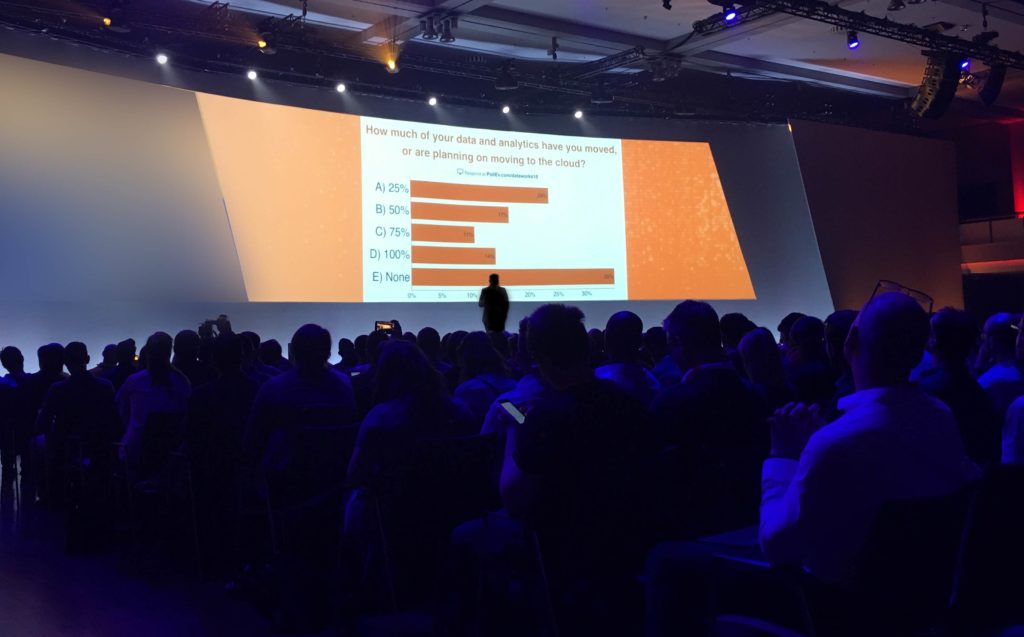Last week in Berlin, data professionals met at the DataWorks Summit Europe to talk about the hottest issues relating to big data management and analytics. Changes to data privacy and protection were the most pressing issue discussed across most sessions, not just due to questions of compliance but rather because it is a microcosm of all things data. Whether it’s the data value chain, governance, management, metadata, or standardization, data control and regulation is the perfect storm. Some even say, new data privacy regulations may be the best thing to happen to data!
Our editorial team attended the event, here’s our 8 key takeaways:
1. A milestone for thinking about data.
Although few of the participants of the event said they were ready for new data privacy regulations (see results of the live poll below), many are seeing them as an opportunity rather than a threat. The reason is that to make big data work, you need to make data, or subsets of your data, useable. The only way to do this is by understanding what data you have.
Implementing privacy and data controls will often mean getting the right metadata, governance and definitions implemented, which in turn can help businesses tag and classify their data so they can better curate it for value. Changes to privacy practices are not just a burden but also an opportunity for the next business model.
The #GDPR deadline is in less than a month, how prepared is your organization? #dws18 pic.twitter.com/OGgvThRgKi
— DataWorksSummit (@DataWorksSummit) April 19, 2018
2. Metadata is the future.
Metadata holds the knowledge about what data is: its source, content, value and purpose. It’s the building blocks of data governance and any future data initiative. Expect to see metadata automation, new standards, unified formats, and metadata exchanges.
3. Data is getting more diverse, and that’s good news.
Data is not only growing, it’s changing. There’s an exponential growth in diversity of content, transactions, feeds and sources that is going far beyond traditional firewalls. In fact, much of the data companies have access to, they didn’t create themselves; it was created by devices outside their firewalls, by an application or a customer.
The good news about this growing diversity of data is that it’s helping businesses make better decisions. For example, tying in customer data with weather information can help retail companies to forecast customer behavior according to meteorological conditions.
[Tweet “From Privacy Regulations to #Metadata – 8 #Data Trends at @DataWorksSummit #DWS18”]
4. There’s a new data lifecycle.
This new way of thinking about data means that nothing on the infrastructure back end remains trivial. If you want to have an understanding of all the data you have collected and understand what data to leverage for monetization, everything needs to be able to communicate across different clouds, operating systems, and architecture models.
5. Hybrid IT is the key operative word.
According to another live poll, over 30% of participants have not, and do not plan to, move data to the cloud (see image below). Even the analysts at the event admitted that they were too feverish on the public cloud. Hybrid IT is how most businesses operate.

5. It’s the people, not the data.
Most companies still don’t know what to do with their data or how to see value from it. That’s because data initiatives require new talent dedicated to data engineering and data science.
Organizations will also need to find ways to transfer skills and provide access to data so that more stakeholders can initiate data-driven use cases. User interfaces that are easy to use, or data interpreters, are structures that can be adopted much quicker that trying to teach thousands of employees to code.
6. The need for standardization.
Whether its metadata, IoT data, or Machine Learning, the new world of data is still a “Wild West.” Without standardization, interoperability is very difficult to implement. If you think of massive IoT scenarios like smart cities, standardization is a critical roadblock to success.
7. Who owns data?
Within the realm of data privacy discussions comes a far larger question around IoT and data ownership. Who owns what data? For example, a health-monitoring device; who owns the data it collects? The device manufacturer? The patient? The Telco providing data communication paths? The answer will likely evolve as the role of data, and data policies, change.
8. Your data and business strategies are one and the same.
The new world of data is a new world of data opportunity. If you had any doubt about what the role of data will be for businesses, the key takeaway from DataWorks Summit is that to ensure longer-term success your business and data strategies need to be aligned.
Western Digital was at the DataWorks Summit sharing our work on HDFS storage tiering using external namespaces on object storage. We’ll have an overview of our presentation in the coming weeks. Subscribe to this blog to get the latest updates!
The evolution of #Hadoop and the #cloud – where to store all that cold data? #DWS18 pic.twitter.com/dCsBNpCWqi
— Western Digital Data Center (@WesternDigiDC) April 18, 2018



